The Real Minuet Breeders
A website dedicated to preventing Minuet (Napoleon) lovers from being scammed by fraudulent websites claiming to be real Minuet (Napoleon) catteries.
Prospective New Minuet Breeders
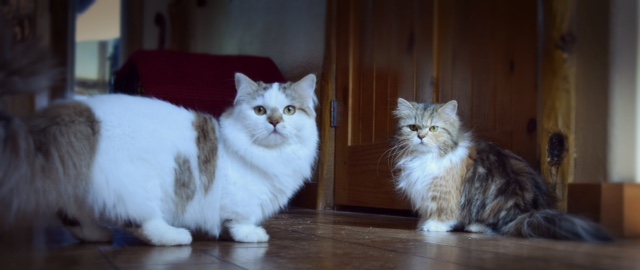 (RW SGC JudysCuties Clawed Lemieux of Tiny Lions and SGM Blueskies Queen Josephine of Tiny Lions)
(RW SGC JudysCuties Clawed Lemieux of Tiny Lions and SGM Blueskies Queen Josephine of Tiny Lions)
So you’re thinking of breeding Minuets (Napoleons). Well, think again, and think hard on it. And when you’re done thinking about it with whimsy, think about it with a rational viewpoint, because no one—and I mean no one—should breed any animal, dog or cat, without first going into the endeavor understanding all the facts. So read on, since this is the real truth behind breeding Minuets (Napoleons).
Breeding Minuets (Napoleons) is unlike most dog and cat breeding. Let’s set aside dogs for now and just focus on how breeding Minuets (Napoleons) differs from other cat breeds. Minuets (Napoleons) are cute, adorable, loving cats, yes, but we’re not going to talk about that. We’re going to talk about the business side of breeding Minuets (Napoleons).
Breeding cats, especially Minuets (Napoleons), is not a money-
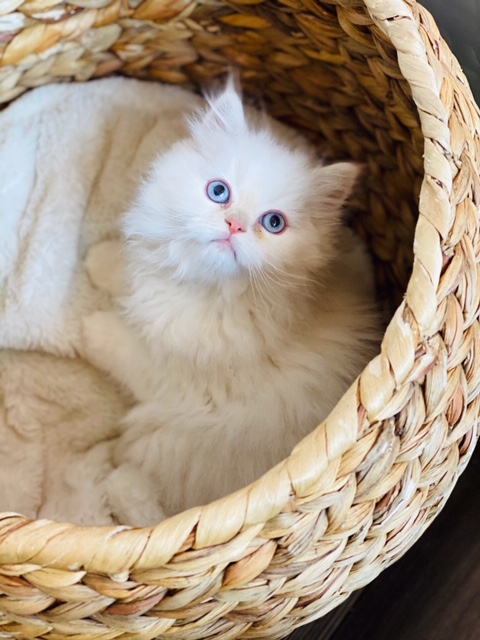 Breeding should not be an impulsive decision. You will have to have patience—an incredible amount of patience—in order to do this properly. For one, you need to court a relationship with a GOOD breeder. Someone who has registered all their cats, vets them extensively to rule out genetic issues, and who has virtually dedicated their life to breeding. Because you lose a lot of freedom when you breed. We’ll get into that a little later on. In the meantime, you’ll have to learn to identify a good breeder you want to work with, then convince that person to mentor you. There is no way to breed without a mentor. Winging it is out of the question. Lives are at stake. If you don’t want a mentor, stop reading this and give up the idea of breeding right now.
Breeding should not be an impulsive decision. You will have to have patience—an incredible amount of patience—in order to do this properly. For one, you need to court a relationship with a GOOD breeder. Someone who has registered all their cats, vets them extensively to rule out genetic issues, and who has virtually dedicated their life to breeding. Because you lose a lot of freedom when you breed. We’ll get into that a little later on. In the meantime, you’ll have to learn to identify a good breeder you want to work with, then convince that person to mentor you. There is no way to breed without a mentor. Winging it is out of the question. Lives are at stake. If you don’t want a mentor, stop reading this and give up the idea of breeding right now.
What does a mentor offer? A mentor offers invaluable expert advice and knowledge that will get you through the initial development of your breeding program. A mentor will steer you in the right direction of how to avoid pitfalls we all have almost—or have—fallen into. A mentor will provide connections with other breeders to find good breeding stock. A mentor will be your emotional support when tragedy occurs. Because tragedy will occur.
Let’s get back to your seemingly unendurable need for patience. You will have to have patience to find the right cats to start out with. You don’t just pick two cats of the opposite sex and think you can start breeding. All cats come in varying quality of their breed. A pedigreed cat can look and act wonderful to the untrained eye, but a good breeder can look at the same kitten and know without question that it isn’t of breeding quality. A good breeder will have an eye for which kittens they consider the best of the breed to propagate the next generation. If a kitten doesn’t make the cut, it is considered pet quality. Make no mistake: Most kittens are and should be considered pet quality. Only the most perfect kitten to match the breed standard should be offered as a breeding cat. This may take time to find. It will take even more time if you are looking for a certain pattern or color to start your breeding program with.
“Okay,” you say, “I’ll wait for a male and female kitten of good breeding quality. That shouldn’t be too difficult.” Wait a minute. Did you think about pedigrees and inbreeding possibilities? Do you even know about inbreeding and line breeding? This is where math and science comes in. Before we take you down that tangent, let me finish up with patience. You’ll have to check pedigrees of your perfect pair of breeding cats to make sure they don’t share close ancestry. I had to wait almost a year for my male stud because of too close ancestry to my girls. Suffice it to say, you won’t be picking up two cats and start breeding if you want to do this right. Again, if you’re not willing to wait, then quit right now.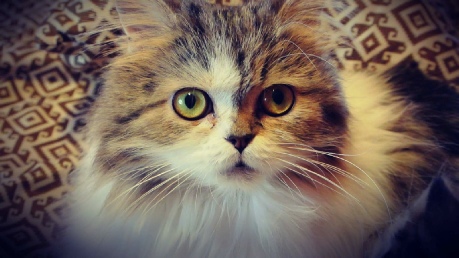
Let’s now take a look at the academics of breeding. Breeding is not to be done by luck or happenstance. Breeding requires a lot of specific knowledge related to cats in general, your chosen breed, genetics, health, associations, and finance. You can definitely start out with a layman’s amount of knowledge on all those, but you have to be willing to learn—and fast. The best thing to do is to start learning while you wait for your first breeding cats to be born. It will take that long to learn even the basics.
I hear you scoff at me at this point, but I’m scowling at your reaction. Knowledge about your breed and breeding in general ensures successful litters. However, when you present yourself to a prospective buyer, you don’t want to look like an idiot. Do you know the proper terms for cat colors and patterns? Do you know how to tell a male cat from a female? What about a kitten that was just born? Can you sex it? Because I know vets who won’t give definitive opinions on gender until the testicles start developing. Good breeders can tell. You have to learn so you don’t misrepresent the sex of your kittens, much less the color.
Identifying color, pattern, and sex of a kitten is parlor tricks next to the more tricky stuff of identifying the coefficient of inbreeding, knowing what genetic maladies your breed may suffer from, or knowing the standards of your breed and how they are applied to the cat itself. Have you read the scientific research that was completed on dwarfism in cats and the cautions pertaining to breeding dwarfism? If you haven’t, you might violate the cardinal rule of breeding Minuets (Napoleons): not to breed the standard version any shorter than nature intends them to be. What about the genetic science behind the Minuet (Napoleon) and the statistics related to offspring from breeding standard to standard, or standard to nonstandard. This is just the beginning.
The good thing is that all of the above is something you can learn, and I suggest you start before you get your first breeding cats. However, what isn’t mentioned is the invaluable pearls of wisdom you’ll only get from a mentor or other breeders. These are cat hacks that will make breeding easier for you. Little tricks of the trade that may save a litter or help a weak kitten start thriving. They can help you find a great food or supplement on the market. So many things you won’t find elsewhere or know how to navigate the ever-
The next topic to discuss in breeding anything, much less Minuets (Napoleons) is cost. It costs a lot to breed, more than you think, and more than you will likely recoup from a litter of kittens. Please see my link to a Cost Analysis worksheet to determine for yourself how much money you will make in breeding. You are likely to see a huge annual loss once the numbers are entered in the worksheet. There are expenses you probably don’t know about, as well as recurring expenses, and unanticipated ones. Let’s look at each category.
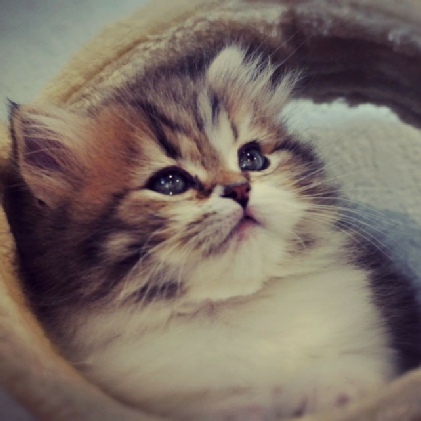 Expenses you can expect in building your breeding program start with your cats. As you know—and what might even be the reason why you think you will make money breeding Minuets (Napoleons)—these cats are not cheap. You will also be paying for breeding rights—extra money for the right to breed cats from someone’s lines. These may qualify as one-
Expenses you can expect in building your breeding program start with your cats. As you know—and what might even be the reason why you think you will make money breeding Minuets (Napoleons)—these cats are not cheap. You will also be paying for breeding rights—extra money for the right to breed cats from someone’s lines. These may qualify as one-
Some expenses you might not know about other than breeding rights are association-
Recurring costs are food, cat litter, and toys, as well as veterinary bills. Quality cat food is expensive and can break a bank; however, scrimping on quality cat food will result in cats that will not be in the best condition for the rigors of breeding. If you think you’ll only need one litter box, think again. You’ll need several. You’ll go through boxes of cat litter like a family goes through cereal. As for toys, they will need replacing often. By far, veterinary bills will take a big chunk out of your wallet. Breeding cats need extra attention. They need annual exams, medical tests to determine if they have any genetic problems that would be detrimental to pass on, and tests to determine if they are healthy themselves to breed. There are vaccinations, teeth cleaning, and visits when they are sick or pregnant. A breeding cat’s health is not something to ignore. It is virtually the only reason to continue to breed. Breeding unhealthy cats is not only ethically wrong, but a horrible detriment to the breed.
Emergency expenses are exactly that: emergencies. When breeding, you must always expect the worst and hope for the best. Every breeder has horror stories of unexpected losses or expenses. A delivery may require an unexpected C-
Not to harp too long on the cost of breeding, which the Worksheet will help you understand better, there is then the time involved in breeding. Ask yourself if you have enough time to dedicate to this endeavor. This time involves taking cats to vet appointments, playing with them to keep them engaged, feeding them, cleaning up after them, AND—wait for it—the actual time involved in having a litter on the ground. Not all mom cats are capable of taking care of a litter. Breeding is not a hands-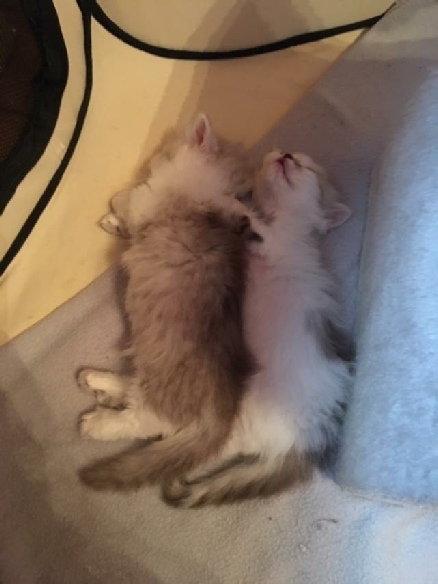
This leads us to the uniqueness of the Minuet (Napoleon) breed with nursing kittens. Your litters will be a mix of standard and nonstandard kittens. As you should know already—if you have done even the most basic research so far—Minuet (Napoleon) kittens are born with their established leg length. This means a newborn standard kitten will already have short legs. A nonstandard kitten will have noticeably longer legs. Fake Minuet (Napoleon) breeders will tell the public that these kittens will develop their “standard” leg length later on in life. This is a bold-
This leads us to the point where you must reflect on your personal lifestyle. Do you like going on trips? Taking spontaneous weekend getaways? You may not be able to with a litter in the house. Who will take care of the cats and kittens? Careful scheduling of breeding will help but what if you have a litter in the fall, one in the winter, and two in the spring and summer. When will you take a vacation? You get the picture? You lose a lot of freedom when you decide to breed.
On a daily basis, do you have time to clean up after your cats? Cats are clean creatures by nature but they leave a mess in the litter box. You will have to clean their boxes to avoid creating an unhealthy, unhygienic environment for both cats and kittens, as well as yourself. You will be doing more laundry when you have a litter and if you have a spraying male. And did you know that some female cats will also spray, just like a male does. Is that something you want to deal with?
Let’s now talk about emotional maturity. Breeding is a very emotional endeavor. You will lose kittens. There is no if, and, or buts about it. It is inevitable. You are even likely to lose an entire litter. Every breeder has lost kittens. Some have even lost whole litters. It is a gut-
Let’s get back to why breeding Minuets (Napoleons) is different than breeding most other cats or dogs. For one, Minuets (Napoleons) generally have small litters. They are likely to have anywhere between one to five kittens in a litter, and a litter will have a mix of standard and nonstandard kittens. So if you are banking on a litter of eight standard kittens to sell at $2,000 a pop, for a total of $16,000 in your pocket, imagine your surprise when you get one nonstandard kitten in a litter that you can sell for $800. It happens more than you think. Or something that happens so often it is discouraging to even the staunchest breeder: losing a kitten before it goes home to a family that has already reserved it. Point being, you don’t count your kittens before they’re hatched. And this is the absolute reason why you don’t breed Minuets (Napoleons) to make money.
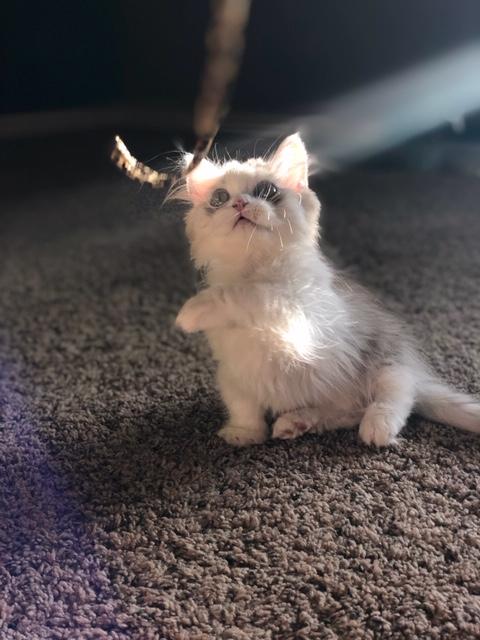 Another reason why breeding Minuets (Napoleons) is different than other breeds is because you will get two versions of the breed in your litters. One version is considered the golden egg, while the other tends to be a disappointment. There is no sugar coating it; every breeder hopes to get standard kittens in their litters. But that just isn’t feasible. There is absolutely nothing wrong with the nonstandard kitten, but in calculating expenses, a nonstandard kitten barely pays for itself. Which leads us to the next caveat in breeding Minuets (Napoleons): finding buyers for your nonstandard kittens.
Another reason why breeding Minuets (Napoleons) is different than other breeds is because you will get two versions of the breed in your litters. One version is considered the golden egg, while the other tends to be a disappointment. There is no sugar coating it; every breeder hopes to get standard kittens in their litters. But that just isn’t feasible. There is absolutely nothing wrong with the nonstandard kitten, but in calculating expenses, a nonstandard kitten barely pays for itself. Which leads us to the next caveat in breeding Minuets (Napoleons): finding buyers for your nonstandard kittens.
Undoubtedly, the Minuet (Napoleon) breed is known primarily as a dwarf cat. This is a sad interpretation of the breed, since it excludes the nonstandards simply because they have legs the length of a normal-
Now here’s what I consider the most important part of breeding any animal: ethics. Are you an ethical, honest person? Do you want to breed because you want to produce better kittens than their parents, so you are always advancing the breed? Are you willing to stick with the rigid requirements of breeding, such as providing quality food, daily fresh water, clean litter boxes, grooming, and required medical care? It’s so easy to skip a day of changing the water because, sure, it looks clean. It couldn’t possibly be a haven for bacteria after several cats have drunk from it. Or, hey, I can diagnose my cat’s diarrhea on my own because I have the Internet at my fingertips. Or, I don’t need DNA tests; the breeder I got these cats from said they were disease-
There are several issues in breeding that you will need to decide on when you start out. Several issues have no truly right or wrong answers. More so, there are camps of thought on these topics. You have to figure out where you stand on each matter yourself and live with your decisions. Those include how many cats you will have in your program, what you will do when you retire a cat from your breeding program, how you will house them, will you spay or neuter your kittens before placing them in homes, sell breeding kittens, and so many other questions. Hopefully, you will have a good mentor who will help guide you along the way, but let’s touch briefly on a few here.
How many cats will you have in your breeding program? The correct answer is no more than you can financially handle and give your attention to. It is so easy to increase the number of cats in your breeding program because you either like this, that, or the other feature in another cat, or you are retiring a female soon, or for whatever reason. But I cannot say this strongly enough: DO NOT ADD MORE CATS THAN YOU CAN HANDLE!! This means mostly financially. If you cannot care for that extra cat without cutting back on expenses, then don’t get it. Each of your cats should be considered gold. They should be treated as gold. Too many breeders stumble into this pitfall and become overburdened with cats. This leads to neglect, and oftentimes what is known in law enforcement as animal cruelty; and in mental health circles as hoarding. 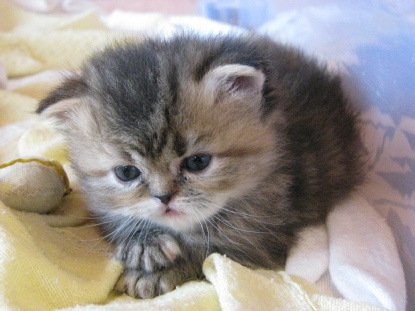
This then leads us to what you might next be thinking in order to add another cat to your program: What to do with a retired breeding cat. It is completely acceptable to re-
A huge question to consider is how you will house your cats. Will they be able to be a part of the family and run loose? In that case, how will you keep your male cat from breeding when you don’t want a female pregnant? How will you separate your male or males from your girls when necessary? Will you keep your male caged? Horrors! How would you like to be kept in a cage your entire life? Will you provide a separate room in your home where you can make him comfortable and have a lot of space to spend his days, with cat toys and furniture and provide him human companionship during the day? Or perhaps you can convert your garage or basement into a stud room? Just remember to allow your male—or females, if they will be living there as well—plenty of sunlight and views of the outside world. There’s a lot to learn, but this article is meant to give you pause for thought before you jump into breeding because you think you can make money from it.
Another question you’ll have to decide is whether you will spay or neuter your kittens before sending them off to their new homes. If you decide not to, you are contributing to a problem that already exists: allowing people to breed cats who shouldn’t be breeding at all. A reputable breeder has exclusive rights to pick who will breed their kittens and which kittens should be bred. They should also vet that prospective new breeder to ensure that the person has the financial means, the time to take care of their breeding program, the intelligence to learn all the intricacies of breeding, the emotional maturity to handle tragedy, and the integrity to become a good breeder. The only reason why breeders don’t spay or neuter their kittens before they go home is because they are cutting costs. They don’t want to spend the money. However, they are allowing people to have breed-
If you have gotten this far in this article, hopefully, the breeder who has agreed to sell you a breeding cat has put you through the rigors of questioning you to make sure you fit the bill. You might think this is an exclusive club, and in essence, that should be what it is, because breeding animals is not a right: it is a privilege. You should prove yourself worthy of being welcomed into the club of good breeders. If you are having any second thoughts, please do not go through with the idea, as it will likely be something you seriously regret.
About the Author:
Catherine Rudy runs Tiny Lions Napoleons and has been breeding Minuets (Napoleons) since 2015. She is invested in this breed and wants to see its continued success. She is very appreciative of the breeder who mentored and sold her her first two breeding Minuets (Napoleons), Kristin Dubois, of Blueskies Cattery.
A realistic reflection on breeding Minuets, directed toward those who are thinking of breeding these beautiful cats. Warning: Not for the faint of heart.